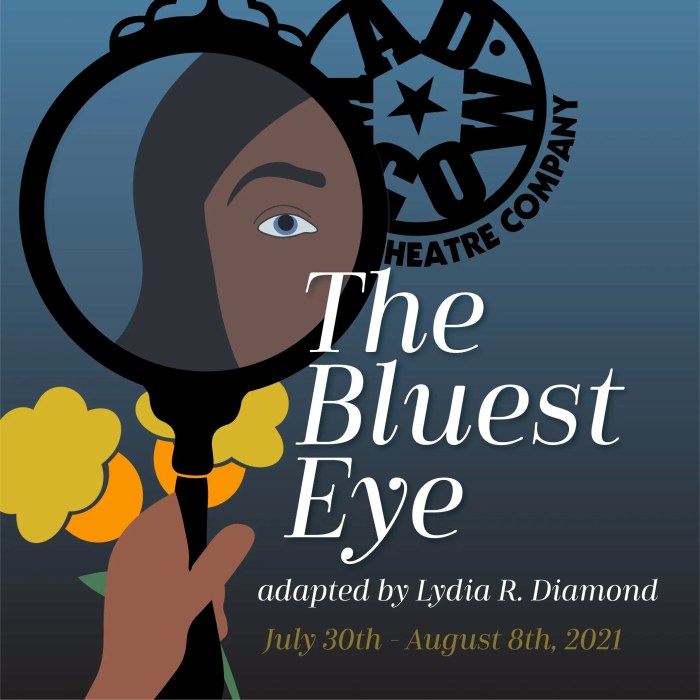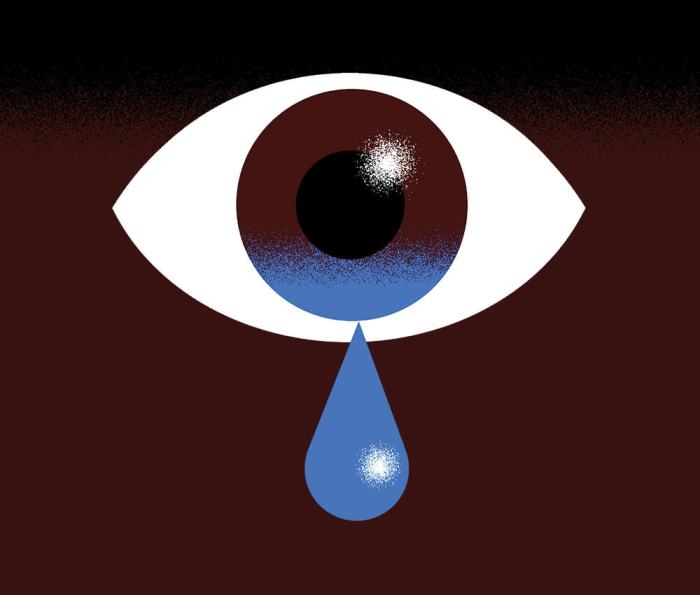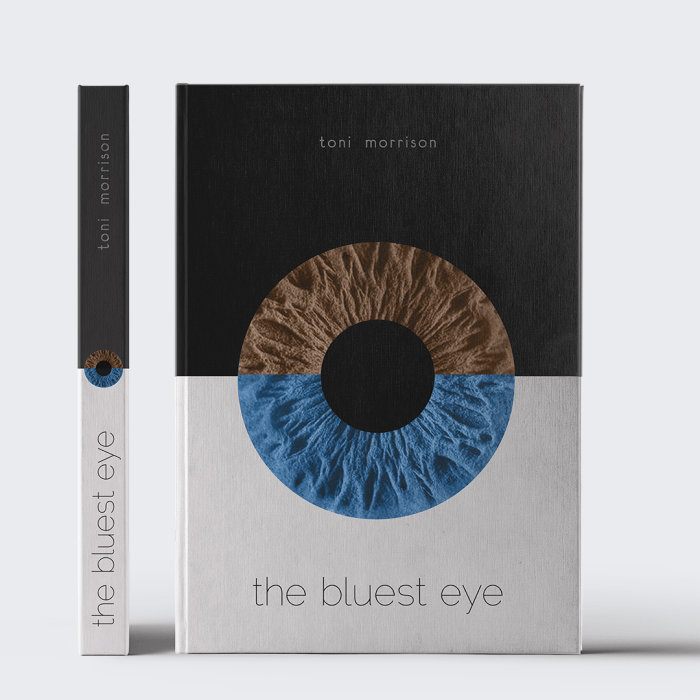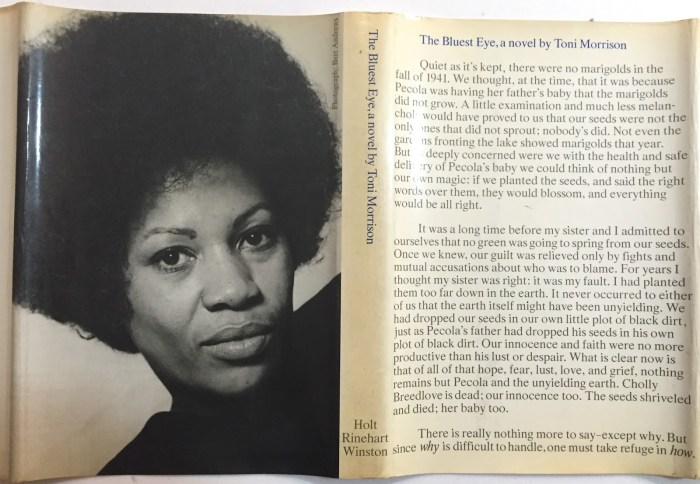Symbols in the bluest eye – In Toni Morrison’s “The Bluest Eye,” symbols play a pivotal role in exploring the complexities of identity, oppression, and the search for hope amidst adversity. Through the lens of Pecola Breedlove’s tragic journey, the novel unveils a poignant and unflinching examination of the profound impact of societal norms, racism, and the pursuit of unattainable beauty standards.
From the haunting symbolism of Pecola’s eyes to the transformative power of nature, Morrison’s masterful use of symbols creates a vivid and emotionally resonant tapestry that invites readers to confront the harsh realities of a society marred by prejudice and inequality.
Symbols of Beauty and Identity

The Bluest Eye explores the complex relationship between beauty, identity, and societal norms. Through the symbolism of Pecola’s eyes, the novel critiques the Eurocentric beauty standards that perpetuate feelings of inferiority and inadequacy within marginalized communities.
Pecola’s Eyes
Pecola’s desire for blue eyes symbolizes her longing for acceptance and validation within a society that values whiteness and Western features. Her belief that blue eyes would make her beautiful highlights the damaging effects of societal beauty standards on her self-perception.
Color and Light
The novel uses color and light to depict the beauty standards imposed on black women. The absence of color in Pecola’s eyes is associated with ugliness and unworthiness, while the presence of light is equated with beauty and desirability. This contrast reinforces the idea that beauty is defined by proximity to whiteness.
Societal Norms
The societal norms that dictate beauty standards are deeply ingrained in Pecola’s community. Characters like Geraldine and Maureen Peal embody these norms, perpetuating the idea that black women with dark skin and features are unattractive. The novel exposes the damaging impact of these norms on the self-esteem and identity of young black girls.
Symbols of Oppression and Trauma

The novel employs powerful symbols to depict the oppressive and traumatic experiences faced by Pecola Breedlove. These symbols reflect the ways in which society’s standards of beauty and racism shape her life.
The White Doll
The white doll that Pecola yearns for embodies the unattainable ideal of beauty imposed on her by a racist society. It represents the white standards of physical perfection that she is made to feel she can never measure up to.
The doll’s blonde hair, blue eyes, and delicate features symbolize the desirability and superiority attributed to whiteness, leaving Pecola feeling inferior and unworthy.
The Blue Eyes
Pecola’s obsession with blue eyes signifies her longing for acceptance and validation. In a world that values whiteness, she believes that having blue eyes would make her beautiful and worthy of love. Her desire for blue eyes reflects the internalized racism that has convinced her that her own features are ugly and undesirable.
The Bluest Eye, Toni Morrison’s debut novel, is rich in symbolism. One striking example is the parable of the sower icon ( parable of the sower icon ). This icon represents the hope and resilience of the novel’s protagonist, Pecola Breedlove, despite the oppressive racism she faces.
The parable’s message of perseverance and growth mirrors the themes of self-discovery and empowerment that permeate The Bluest Eye.
Racism and Discrimination
The novel unflinchingly portrays the racism and discrimination that Pecola faces throughout her life. These experiences contribute to her low self-esteem and feelings of worthlessness. From the casual slurs she hears at school to the overt violence she witnesses, Pecola’s daily reality is shaped by the oppressive forces of a racist society.
Symbols of Hope and Resistance

In the midst of oppression and trauma, The Bluest Eye offers glimmers of hope and resistance through its symbolism.Nature emerges as a source of solace and strength for the characters, particularly Pecola Breedlove. Marigolds, vibrant and resilient flowers, become a symbol of hope amidst the bleakness.
Despite being planted in a vacant lot, the marigolds bloom beautifully, representing the possibility of beauty and joy even in the most desolate places.The dandelion, often considered a weed, also serves as a symbol of resilience. Its ability to thrive in harsh conditions mirrors the strength and determination of those who endure oppression.
Pecola finds solace and inspiration in the dandelion’s ability to survive and flourish despite its marginalized status.
Symbolism in the Natural World: Symbols In The Bluest Eye

The natural world in The Bluest Eyeis rich with symbolism, reflecting the characters’ emotions and experiences.
Water
- Symbol of purification and renewal:Pecola washes away her dirt and shame in the rain, but it fails to cleanse her.
- Symbol of oppression:The white lake where Pecola’s parents drown is a reminder of the racial barriers that keep them from a better life.
Fire
- Symbol of destruction:The burning of the Breedloves’ house represents the destruction of their dreams and hopes.
- Symbol of passion:The fire between Pecola and Cholly is both destructive and consuming.
Earth
- Symbol of fertility and growth:The garden where Claudia and Frieda play represents the possibility of a better future.
- Symbol of oppression:The dirt that Pecola eats is a reminder of her poverty and low self-esteem.
Air
- Symbol of freedom:The wind that blows through the streets represents the possibility of escape from oppression.
- Symbol of oppression:The suffocating air in the Breedloves’ house represents the weight of their poverty and despair.
Symbolism in the Built Environment

The built environment in The Bluest Eye plays a significant role in shaping the novel’s themes and atmosphere. The settings, from the Breedloves’ home to the school and hospital, each carry symbolic meanings that contribute to the exploration of beauty, identity, oppression, and resistance.
The Breedloves’ Home
The Breedloves’ home is a symbol of poverty, neglect, and oppression. The house is described as “a small, weather-beaten frame house” that is “surrounded by a narrow yard filled with trash and weeds.” The interior of the house is equally squalid, with “broken furniture, dirty dishes, and piles of laundry.”
The home’s dilapidated condition reflects the Breedloves’ own poverty and social marginalization.
The School
The school is a symbol of hope and possibility for the Breedloves’ children. However, the school is also a place of oppression and humiliation. The teachers are racist and unsympathetic, and the students are constantly bullied. The school’s failure to provide a safe and supportive learning environment for the Breedloves’ children reflects the systemic racism that pervades American society.
The Hospital, Symbols in the bluest eye
The hospital is a symbol of hope and healing. Pecola Breedlove is taken to the hospital after she is raped by her father. The hospital staff is kind and compassionate, and they provide Pecola with the care and support she needs.
The hospital’s positive atmosphere contrasts sharply with the Breedloves’ home and the school, and it offers a glimmer of hope for Pecola’s future.
General Inquiries
What is the significance of Pecola’s eyes as a symbol?
Pecola’s eyes represent her longing for a sense of beauty and acceptance that eludes her due to societal standards that value whiteness and blue eyes.
How does the white doll symbolize the unattainable beauty standards imposed on Pecola?
The white doll embodies the idealized image of beauty that Pecola internalizes, leading her to believe that her own dark skin and features are inferior.
What role does nature play in providing solace and strength to Pecola?
The marigolds and dandelion symbolize Pecola’s resilience and her ability to find beauty and hope in the natural world, despite the hardships she faces.
